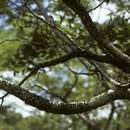en
names in breadcrumbs


Pilostyles is a genus of flowering plants in the family Apodanthaceae. It includes about 11 species of very small, completely parasitic plants that live inside the stems of woody legumes.[1][2] Plants of this genus are sometimes referred to as stemsuckers.[3]
The plants completely lack stems, roots, leaves, and chlorophyll. While not flowering, they do not resemble most plants, living entirely inside the host as " [...] a mycelium-like endophyte formed by strands of parenchyma cells that are in close contact to the host vasculature".[4] Their presence is only noticeable when the flowers emerge out of the stems of the host plant.[2]
Pilostyles is dioecious, with separate male and female plants.[5] Male and female plants are not commonly known to inhabit the same host.[6] Flowers are two or three millimeters wide and in some species each female flower can produce over 100 seeds, which are less than 1mm long.[7] [6]
Species are found in several countries, with a discontinuous distribution: species have been found in the United States, Mexico, Venezuela, Iran, Syria, and Australia.[8]
Species include:[1]
The genus was formerly considered a member of Rafflesiaceae, and was re-classified after new DNA evidence[9][8]
Pilostyles is a genus of flowering plants in the family Apodanthaceae. It includes about 11 species of very small, completely parasitic plants that live inside the stems of woody legumes. Plants of this genus are sometimes referred to as stemsuckers.
The plants completely lack stems, roots, leaves, and chlorophyll. While not flowering, they do not resemble most plants, living entirely inside the host as " [...] a mycelium-like endophyte formed by strands of parenchyma cells that are in close contact to the host vasculature". Their presence is only noticeable when the flowers emerge out of the stems of the host plant.
Pilostyles is dioecious, with separate male and female plants. Male and female plants are not commonly known to inhabit the same host. Flowers are two or three millimeters wide and in some species each female flower can produce over 100 seeds, which are less than 1mm long.
Species are found in several countries, with a discontinuous distribution: species have been found in the United States, Mexico, Venezuela, Iran, Syria, and Australia.
Species include:
Pilostyles aethiopica Welw. Pilostyles berteroi Guill. Pilostyles blanchetii (Gardner) R.Br. Pilostyles boyacensis F.Gonzáles & Pabón-Mora Pilostyles coccoidea K.R.Thiele Pilostyles collina Dell Pilostyles hamiltonii C.A.Gardner Pilostyles haussknechtii Boiss. Pilostyles maya P.Ortega, Gonz.-Martínez & S.Vásquez Pilostyles mexicana (Brandegee) Rose Pilostyles thurberi A.GrayThe genus was formerly considered a member of Rafflesiaceae, and was re-classified after new DNA evidence
Pilostyles es una género de planta parásita perteneciente a la familia Apodanthaceae.[1] Se distribuye desde Estados Unidos hasta Brasil.
Pilostyles fue descrito por Jean Baptiste Antoine Guillemin y publicado en Annales des Sciences Naturelles; Botanique, sér. 2, 2: 21, en el año 1834.[2] La especie tipo es: Pilostyles berteroi Guill.
Pilostyles es una género de planta parásita perteneciente a la familia Apodanthaceae. Se distribuye desde Estados Unidos hasta Brasil.
Pilostyles est un genre de plantes dicotylédones de la famille des Apodanthaceae, originaire de diverses régions tropicales, qui comprend une vingtaine d'espèces acceptées. Ce sont des espèces de plantes endoparasites, dépourvues de racines et de chlorophylle, qui vivent à l'intérieur de leur hôtes et restent invisibles jusqu'à la floraison, lorsque les fleurs de quelques millimètres de diamètre émergent à la surface des tissus de l'hôte. Ces parasites dioïques, sont spécialisés dans les espèces ligneuses de Fabaceae.
Selon The Plant List (26 janvier 2020)[3] :
Pilostyles est un genre de plantes dicotylédones de la famille des Apodanthaceae, originaire de diverses régions tropicales, qui comprend une vingtaine d'espèces acceptées. Ce sont des espèces de plantes endoparasites, dépourvues de racines et de chlorophylle, qui vivent à l'intérieur de leur hôtes et restent invisibles jusqu'à la floraison, lorsque les fleurs de quelques millimètres de diamètre émergent à la surface des tissus de l'hôte. Ces parasites dioïques, sont spécialisés dans les espèces ligneuses de Fabaceae.
Pilostyles, biljni rod endoparazitskih biljaka u porodici Apodanthaceae, dio reda Cucurbitales. Postoji nekoliko vrsta koje parazitiraju na drveću porodice Leguminosae, a raširene su u Sjevernoj i Južnoj Americi, Africi i Zapadnoj Australiji i Iranu.[1]
Endoparaziti živi unutar drveta, a samo cvijeće pojavljuje na manjim granama domaćina.
Pilostyles, biljni rod endoparazitskih biljaka u porodici Apodanthaceae, dio reda Cucurbitales. Postoji nekoliko vrsta koje parazitiraju na drveću porodice Leguminosae, a raširene su u Sjevernoj i Južnoj Americi, Africi i Zapadnoj Australiji i Iranu.
Endoparaziti živi unutar drveta, a samo cvijeće pojavljuje na manjim granama domaćina.
Pilostyles là chi thực vật có hoa trong họ Apodanthaceae.[1]
Pilostyles là chi thực vật có hoa trong họ Apodanthaceae.
豆生花属(学名:Pilostyles)是风生花科下的一属,约有25种,多数种类产于加利福尼亚南部至热带美洲,另有2种产澳大利亚西部。本属植物不进行光合作用,是一类全寄生植物,寄生于豆科植物的体内,花开在寄主的茎干表面。[1][2][3]